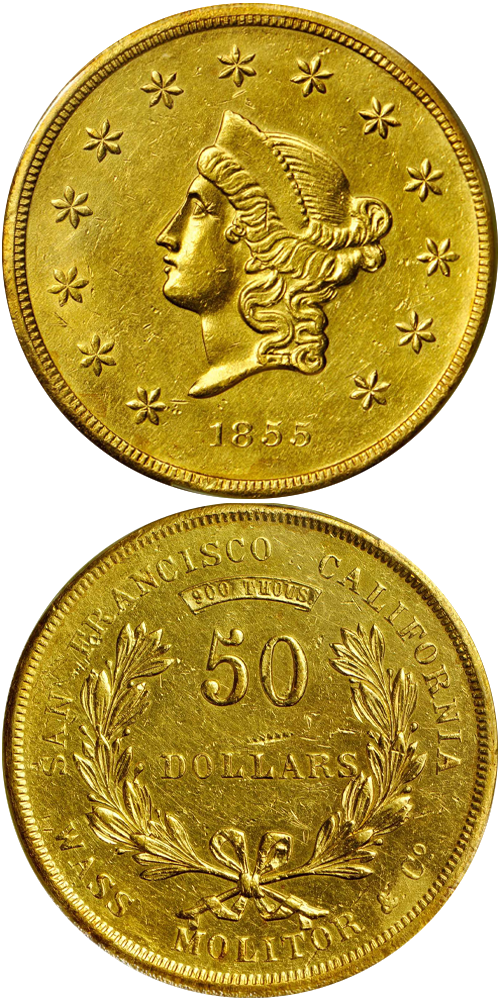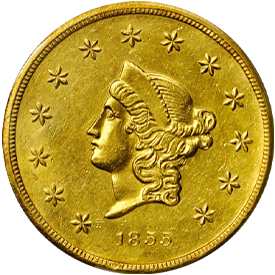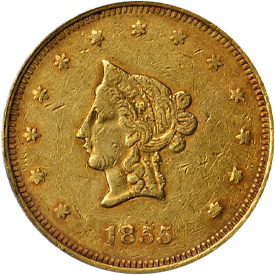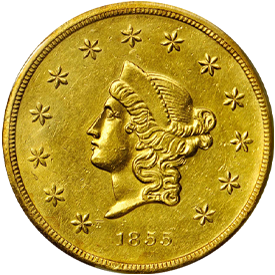Among the private issuers of gold coins in San Francisco, Wass, Molitor & Co. was one of the most important, although their initial production did not begin until relatively late, in 1852. Count S.C. Wass and A.P. Molitor, Hungarians, earlier were engaged in refining and assaying, according to a notice in the San Francisco Herald on November 19, 1851:
Messrs. Wass, Molitor & Co. have removed their establishment into Naglee's Fireproof Building, in Merchant St., where they are now busily engaged in smelting irons of all kinds, melting down and assaying gold for the largest houses in the city, and attending generally to all business connected with mining, for which their scientific attainments and long experience eminently fit them. They have now an excellent laboratory, fitted up in the most approved style, with powerful furnaces and every species of apparatus required for the most delicate and accurate analysis.
These gentlemen have acquired a thorough and practical knowledge of mining and all its ramifications in the celebrated School of Mines of Germany, having perfected that knowledge by working in the gold mines of their native land — Hungary — for many years, and later those of this country.
They are prepared to furnish mining plans and information as to the best and cheapest method of working the mines, which will be invaluable at the present time when attention is so much directed toward them. We consider the scientific experience of these gentlemen a valuable acquisition to the state. They are compatriots and were companions-in-arms of the heroic Kossuth throughout the memorable Hungarian Revolution. Their hope of liberty in their native land crushed, their fortunes confiscated, and themselves exiled by the ruthless Austrian, they have sought a home in our land, the refuge of the oppressed of every nation.
Toward the latter part of 1851 a severe scarcity of small coins in circulation developed. Moffat & Co., the most respected coiners at the time, petitioned the Treasury Department for permission to coin small denomination issues, but their pleas were rejected. At the time $50 slugs were the only plentiful coins in circulation, thus inflicting great hardship upon customers and merchants engaging in transactions involving lesser amounts. Recognizing the need for small coins, Wass, Molitor & Co. prepared a $ 5 piece similar to the United States Mint issue and design but with inscriptions pertaining to the private firm. The Daily Alta California of January 8, 1 852 noted:
The day before yesterday we were shown a piece of the denomination $5 which Messrs. Wass, Molitor & Co. are preparing to issue from their assay office, Naglee's Building, in Merchant St. It has the head and stars like the American coin, with the letters WM & CO. in the place occupied by the word LIBERTY on our National currency. Below is the date, 1852. On the reverse is the eagle, with the words 'In California Gold-Five Dollars' around it. The coin has the pale yellow appearance which is peculiar to the private coinage of the State, and which is caused by the silver alloy natural to the gold, whereas the issues from the United States Mint are slightly alloyed with copper.
On the same date another newspaper, the San Francisco Herald, commented, here quoted in part:
The very serious inconveniences to which the people of California have been subjected through the want of a mint, and the stream of unwieldy slugs that have issued from the United States Assay Office have imperatively called for an increase of small coins. The well known and highly respectable firm of Wass, Molitor & Co. have come forward in this emergency, and are now issuing a coin of the value of $5 to supply the necessities of trade. Their coining establishment, located in Naglee's fireproof brick building in Merchant St., is now complete, being provided with the most powerful and improved machinery for such purposes…
The high reputation for honor and integrity enjoyed by Count Wass and his associates in this enterprise is additional guaranty that every representation made by them will be strictly complied with. The public will be glad to have a coin in which they can feel confidence, and which can't depreciate in their hands. The leading bankers, too, sustained and encouraged this issue, and will receive it on deposit. Among others are the heavy houses of Adams & Co., Burgoyne & Co., and Page, Bacon & Co.
Messrs. Wass, Molitor & Co. coining establishment, which is entirely disconnected from the smelting and assaying office, now in active operation, is capable of turning out from $7,000 to $8,000 in five dollar pieces per day.
A description of the minting process employed by Wass, Molitor & Co. and their facilities appeared in the San Francisco Herald of January 17, 1852:
We gave a detailed description a few days ago of the new Five Dollar piece issued by this enterprising firm. Since then they have prepared a die for coining Ten Dollar pieces, some of which we have seen struck off. They are superior in mechanical execution to the Five Dollar pieces, and will compare favorably with any coin now on the market. They are similar to the smaller coin, with the exception of being stamped on one side,
"SMV (standard mint value) Ten Dollars." A quantity of their coin has been sent on to the Mint by the bankers who receive it, so that by an official assay the public may be entirely satisfied that it is worth all that it purports to be.The process by which the crude gold dust is converted into coin is quite intricate and interesting. The metal has to pass through half a dozen different stages in the hands of a dozen workmen before it is turned out of the press ready for circulation. In the first place the dust is placed in suitable vessels and smelted by the heat of a powerful furnace. In its molten state it is run into thick bars or ingots. These are separately assayed with extreme care and nicety by Count Wass. The fineness of each bar being ascertained, silver is either added or subtracted, according as it is above or below the standard fineness, so as to attain a uniform mixed degree of purity. It will be remembered that there is no alloy of copper in these coins as in those issued from the United States Mint, and hence they have a lighter yellow color.
After the bars have been made of a requisite fineness they are resmelted and cast into smaller bars. These are hammered out, then drawn through slits in a powerful machine — the width of the slit being diminished. By this means it is made to assume the shape of a golden hoop. It is then drawn through a powerful rolling machine graduated to the required thickness, from which it issues a long, thin strip, brightly polished, and of the thickness of the coin. It is then placed under another ingenious machine in which it is cut up into circular pieces the size of the proposed coin. These pieces are generally adjusted to the standard weight on very nice scales prepared for the purpose. If they weigh a little too much, as they always do, they are reduced by filing. They are now ready to be stamped.
The first stage in this process consists in placing them in a milling machine of great power. From this they receive a neat, raised milled edge. Nothing remains now but to place them in the press, where they are stamped. This press operates on the principle of the screw. The circular piece of gold — the embryo coin — is placed upon a die which is to give its impress to one side, while another die, which stamps the other side, is made to descend with great force by whirling the heavily loaded arms of a lever passing through the screw. It is a current Five or Ten Dollar piece, as the case may be. The finishing touch is put to it by roasting it, so as to give it a bright color. All these different processes of course require great scientific and mechanical skill, extreme accuracy, and heavy and complete machinery. All of these requisites Messrs. Wass, Molitor & Co. possess.
In 1852 pieces of the $5 and $10 denomination were made. No pieces were struck, so far as is known, bearing the dates 1853 or 1854. In 1855 denominations of $10, $20 and $50 were made. The $50 pieces were round and were the only pieces of that shape and denomination to circulate. Of attractive appearance, the coins found ready acceptance in the marketplace. Large numbers were coined. The Sacramento Daily Union of April 30, 1855 reported:
Col. Pardee of Wells, Fargo & Co.'s Express has exhibited to us the new Fifty Dollar piece which in a great measure is destined to supplant the old fashioned octagon slug now in circulation. This coin is circular, almost entirely destitute of ornament, and plain as a maiden's countenance who has breathed the air of fifty summers. At the outer edge of one side are the words "Wass, Molitor & Co. San Francisco," enclosing on the centre of the coin the figures "900" and abbreviated word "Thous." with the figures "50" underneath and the word "Dollar" below the latter figures. On the reverse of the coin is a homely head of Liberty and the figures "1855." The coin certainly has no pretentions to beauty; nevertheless we would not like to refuse a few to break with our friends.
The Alta California reported on May 16, 1855:
Wass, Molitor & Co. have commenced issuing their Fifty and Twenty Dollar pieces at the rate of $38,000 per day. The coin is above the United States standard, and is confidently received throughout the state.
Today, Wass, Molitor & Co. is best remembered for their immense 1855 $50 round "slug."









